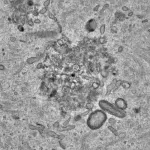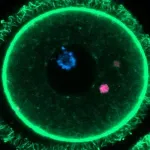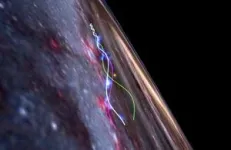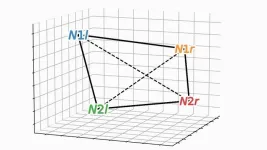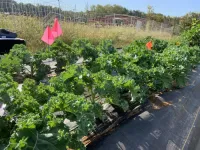(Press-News.org) Oocytes are immature egg cells that develop in almost all female mammals before birth. The propagation of future generations depends on this finite reserve of cells surviving for many years without incurring damage. In mice, this can be a period of up to eighteen months, while in humans it can last almost half a century, the average time between birth and menopause. How the cells accomplish this remarkable feat of longevity has been a longstanding question.
Researchers at the Centre for Genomic Regulation (CRG) in Barcelona have discovered a new mechanism which explains how oocytes remain in pristine conditions for decades without succumbing to the wear and tear that would cause other cell types to fail. The findings, reported today in the journal Cell, represent a new frontier to explore unexplained causes of infertility.
The researchers looked at protein aggregates, which are clumps of misfolded or damaged proteins. If left unchecked, these harmful substances accumulate in the cytoplasm and have highly toxic effects. Protein aggregates are known to accumulate in neurons and their effects have been linked to several neurodegenerative diseases. Cells usually manage aggregates by breaking them down with specialized enzymes. They can also divide into two new cells, concentrating aggregates in one of the cells and sparing the other.
But oocytes are not like the other cells. Their long life means they cannot dissipate toxic substances through cell division. Constantly breaking down protein aggregates is an inviable strategy, as it requires using a high amount of energy that may not be available. Oocytes also have the job of donating their entire cytoplasm to an embryo after fusing with a sperm, and so prefer to reduce their metabolic activity, a strategy which avoids generating by-products which can damage the maternal DNA and compromise future reproductive success. This makes oocytes particularly sensitive to the effects of misfolded or damaged proteins.
However, “in contrast to the tens of thousands of papers on protein aggregation in neurons, how mammalian oocytes cope with protein aggregation is essentially unstudied, despite having the same problem of being long-lived and non-dividing”, explains Dr. Elvan Böke, Group Leader of the Oocyte Biology & Cellular Dormancy programme at the Centre for Genomic Regulation and author of the study. “We wanted to explore how oocytes deal with these misfolded or damaged proteins”, adds Dr. Böke.
Patrolling ‘clean-up crews’
Dr. Böke’s team, led by Dr. Gabriele Zaffagnini, started by collecting thousands of immature oocytes, mature eggs, and early embryos from adult mice. Using special dyes, they observed how the protein aggregates behave in real-time using a technique called live-cell imaging. They also used electron microscopy to get a closer look and see nanoscopic details inside cells, work that took five and a half years to complete.
The researchers discovered special structures in the oocytes which they named EndoLysosomal Vesicular Assemblies – or ELVAs for short. These structures – there are about 50 per each oocyte - roam the cytoplasm, where they capture and hold onto protein aggregates, rendering them harmless. Cells have many subcellular structures known as organelles, which perform jobs much like an organ does in the body. The researchers conceptualise ELVAs as a “superorganelle” because it is a network of many different types of cellular components working together as a single unit.
The study revealed a crucial moment during the oocyte maturation stage, which is when an oocyte converts into a mature egg, preparing for ovulation and possible fertilisation. During this stage, the researchers observed ELVAs moving towards the cell's surface and breaking down the protein aggregates, essentially deep-cleaning the cytoplasm. This is the first observation of the unique strategy oocytes employ to get rid of protein aggregates.
“An oocyte must donate all its cytoplasm to the embryo at fertilisation, so it cannot afford for garbage to accumulate, which would pose an existential risk for its function. In that sense, ELVAs are like a sophisticated waste disposal network or clean-up crew, patrolling the cytoplasm to ensure no aggregates are freely floating. ELVAs keep these aggregates in a confined environment until the oocyte is ready to dispose of them in one fell swoop. It’s an effective and energy-efficient strategy,” says Dr. Zaffagnini, postdoctoral researcher at the Centre for Genomic Regulation.
Protein aggregates may contribute to infertility
Fertility declines with age, and poor oocyte quality is the major cause of female infertility. Global infertility rates are also on the rise, with delayed motherhood being one of the contributing factors. Understanding how oocytes remain healthy, and what causes these strategies to fail with age, is critical for understanding unexplained causes of infertility and open up new avenues for treatment.
The findings of the study suggest that the presence of protein aggregates could interfere with both egg and embryo quality. When the researchers experimentally prevented the ability of ELVAs to degrade protein aggregates during the oocyte maturation process, it led to the formation of defective eggs. When the researchers intervened and “forced” the embryos to inherit aggregated proteins, 3 in 5 (60%) failed to complete very early stages of development.
“A lot of studies have historically focused on one small aspect of why oocyte quality declines, which are meiosis and euploidy. However, a recent review of eleven thousand embryo transfers has shown that the decline in female fertility with age are heavily influenced by other, yet unknown factors. Our research opens a fascinating future direction to explore whether protein degradation, and problems with how they are regulated in oocytes, could explain the age-related decline in embryo health,” concludes Dr. Böke.
Another type of long-lived cell which do not divide yet have to deal with protein aggregates are neurons. The accumulation of the harmful substances in these cells is linked to the development of several types of neurodegenerative diseases including Alzheimer’s. Could ELVA-like compartments also exist in neurons and other cell types? The study opens the door for future research avenues beyond the field of reproduction.
END
Oocytes outsmart toxic proteins to preserve long-term female fertility
Protein aggregates in neurons are linked to diseases like Alzheimer’s. The build-up of these toxic proteins may also influence oocyte quality and female fertility, according to a study in Cell
2024-02-20
ELSE PRESS RELEASES FROM THIS DATE:
The Radcliffe Wave is waving
2024-02-20
A few years ago, astronomers uncovered one of the Milky Way’s greatest secrets: an enormous, wave-shaped chain of gaseous clouds in our sun’s backyard, giving birth to clusters of stars along the spiral arm of the galaxy we call home.
Naming this astonishing new structure the Radcliffe Wave, in honor of the Harvard Radcliffe Institute, where the undulation was originally discovered, the team now reports in Nature that the Radcliffe Wave not only looks like a wave, but also moves like one – oscillating through space-time much like “the wave” moving through a stadium full of fans.
Ralf Konietzka, the paper’s ...
Examining excess mortality associated with the pandemic for renters threatened with eviction
2024-02-20
About The Study: Housing instability, as measured by eviction filings, was associated with a significantly increased risk of death over the first 20 months of the COVID-19 pandemic in this study that included 282,000 renters who received an eviction filing. Eviction prevention efforts may have reduced excess mortality for renters during this period.
Authors: Nick Graetz, Ph.D., of Princeton University in Princeton, New Jersey, is the corresponding author.
To access the embargoed study: Visit ...
Fresh meat: New biosensor accurately and efficiently determines meat freshness
2024-02-20
WASHINGTON, Feb. 20, 2024 — The freshness of animal meat is an essential property determining its quality and safety. With advanced technology capable of preserving food for extended periods of time, meat can be shipped around the globe and consumed long after an animal dies. As global meat consumption rates increase, so too does the demand for effective measures for its age.
Despite the technological advances keeping meat fresh for as long as possible, certain aging processes are unavoidable. Adenosine triphosphate (ATP) ...
Large, diverse genetic study of glaucoma implicates vascular and cancer-related genes
2024-02-20
An international genetic study using multiancestry biobanks has identified novel genetic locations associated with primary open-angle glaucoma (POAG), the most common type of glaucoma and the leading cause of irreversible blindness globally. The findings, published Feb. 20 in Cell Reports Medicine, detail ancestry- and sex-specific genetic loci associated with POAG and implicate vascular and cancer-related genes in POAG risk.
“Although there has been significant progress using genome-wide association studies (GWAS) to explore the genetic pathophysiology of glaucoma in humans, there is still a lack of understanding of the underlying ...
HPV vaccination among young adults before and during the pandemic
2024-02-20
About The Study: The results of this study suggest that human papillomavirus (HPV) vaccination coverage among young adults did not increase during the COVID-19 pandemic compared with prior years. This finding likely reflects pandemic-related disruptions in initiating the HPV vaccine among young adults.
Authors: Kalyani Sonawane, Ph.D., of the Medical University of South Carolina in Charleston, is the corresponding author.
To access the embargoed study: Visit our For The Media website at this link https://media.jamanetwork.com/
(doi:10.1001/jamanetworkopen.2023.56875)
Editor’s Note: Please see the article for ...
Historical redlining, persistent mortgage discrimination, and race in breast cancer outcomes
2024-02-20
About The Study: In a study of 1,764 women with breast cancer, living in a historically redlined area was associated with increased odds of a diagnosis of estrogen receptor–negative breast cancer in non-Hispanic Black women and increased odds of late-stage diagnosis in non-Hispanic white women. Persistent mortgage discrimination was associated with an increase in breast cancer mortality in non-Hispanic white women, and non-Hispanic Black women were more likely to die of breast cancer no matter where they lived.
Authors: Jasmine M. Miller-Kleinhenz, Ph.D., of Emory University in Atlanta, is the corresponding author.
To ...
Ancient genomes reveal Down Syndrome in past societies
2024-02-20
For many years, researchers at MPI-EVA have been collecting and analyzing ancient DNA from humans who lived during the past tens of thousands of years. Analyzing these data has allowed the researchers to trace the movement and mixing of people, and even to uncover ancient pathogens that affected their lives. However, a systematic study of uncommon genetic conditions had not been attempted. One of those uncommon conditions, known as Down Syndrome, affects nowadays around one in 1,000 births.
To their surprise, Adam “Ben” Rohrlach and colleagues identified six individuals ...
Can a single brain region encode familiarity and recollection?
2024-02-20
NEW YORK, NY — The human brain has the extraordinary ability to rapidly discern a stranger from someone familiar, even as it can simultaneously remember details about someone across decades of encounters. Now, in mouse studies, scientists at Columbia's Zuckerman Institute have revealed how the brain elegantly performs both tasks.
“These findings are the first evidence that a single population of neurons can use different codes to represent novel and familiar individuals,” said co-corresponding author Stefano Fusi, PhD, professor of neuroscience at Columbia’s Vagelos College of Physicians and ...
Pesticides found in kale but at low risk levels
2024-02-20
Kale fans can rest easy knowing pesticides used to grow the hearty greens are unlikely to end up in their salads or smoothies, a new chemical analysis of the superfood suggests.
Conducting novel tests that provide the most complete picture to date of a crop’s chemical makeup, the Johns Hopkins–led team found several pesticides and compounds in Maryland-farmed kale—but no cause for alarm.
“We do see minute traces of pesticides in the kale, but the levels we found are so much lower ...
Stress during pregnancy can lead to early maturation of first-born daughters
2024-02-20
Key takeaways
A UCLA-led research team found a correlation between certain aspects of early puberty in first-born daughters and high levels of prenatal stress in their mothers.
The researchers did not find the same result in boys or in daughters who were not first-born.
This early maturation may enable a first-born daughter to help her mother rear her other children successfully, according to UCLA anthropologist Molly Fox.
A UCLA-led team of researchers has found a correlation between early signs of adrenal puberty in first-born daughters ...
LAST 30 PRESS RELEASES:
Automatic label checking: The missing step in making reliable medical AI
Low daily alcohol intake linked to 50% heightened mouth cancer risk in India
American Meteorological Society announces Rick Spinrad as 2026 President-Elect
Biomass-based carbon capture spotlighted in newly released global climate webinar recording
Illuminating invisible nano pollutants: advanced bioimaging tracks the full journey of emerging nanoscale contaminants in living systems
How does age affect recovery from spinal cord injury?
Novel AI tool offers prognosis for patients with head and neck cancer
Fathers’ microplastic exposure tied to their children’s metabolic problems
Research validates laboratory model for studying high-grade serous ovarian cancer
SIR 2026 delivers transformative breakthroughs in minimally invasive medicine to improve patient care
Stem Cell Reports most downloaded papers of 2025 highlight the breadth and impact of stem cell research
Oxford-led study estimates NHS spends around 3% of its primary and secondary care budget on the health impacts of heat and cold in England
A researcher’s long quest leads to a smart composite breakthrough
Urban wild bees act as “microbial sensors” of city health.
New study finds where you live affects recovery after a hip fracture
Forecasting the impact of fully automated vehicle adoption on US road traffic injuries
Alcohol-related hospitalizations from 2016 to 2022
Semaglutide and hospitalizations in patients with obesity and established cardiovascular disease
Researchers ‘listen in’ to embryo-mother interactions during implantation using a culture system replicating the womb lining
How changing your diet could help save the world
How to make AI truly scalable and reliable for real-time traffic assignment?
Beyond fragmented markets: A new framework for efficient and stable ride-pooling
Can shape priors make road perception more reliable for autonomous driving?
AI tracks nearly 100 years of aging research, revealing key trends and gaps
Innovative techniques enable Italy’s first imaging of individual trapped atoms
KIER successfully develops Korea-made “calibration thermoelectric module” for measuring thermoelectric device performance
Diversifying US Midwest farming for stability and resilience
Emphasizing immigrants’ deservingness shifts attitudes
Japanese eels, climate change, and river temperature
Pusan National University researchers discover faster, smarter heat treatment for lightweight magnesium metals
[Press-News.org] Oocytes outsmart toxic proteins to preserve long-term female fertilityProtein aggregates in neurons are linked to diseases like Alzheimer’s. The build-up of these toxic proteins may also influence oocyte quality and female fertility, according to a study in Cell
